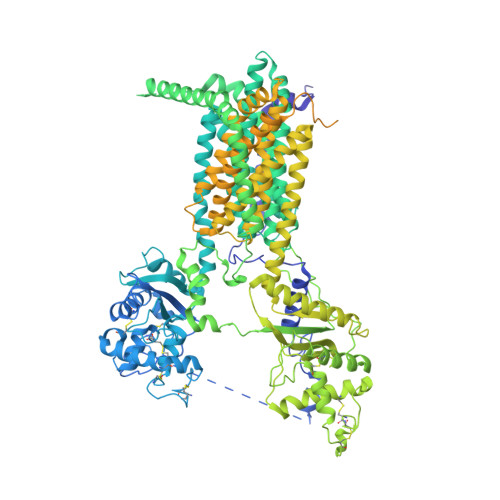Dispatched uses Na + flux to power release of lipid-modified Hedgehog.
Wang, Q., Asarnow, D.E., Ding, K., Mann, R.K., Hatakeyama, J., Zhang, Y., Ma, Y., Cheng, Y., Beachy, P.A.(2021) Nature 599: 320-324
- PubMed: 34707294
- DOI: https://doi.org/10.1038/s41586-021-03996-0
- Primary Citation of Related Structures:
7RPH, 7RPI, 7RPJ, 7RPK - PubMed Abstract:
The Dispatched protein, which is related to the NPC1 and PTCH1 cholesterol transporters 1,2 and to H + -driven transporters of the RND family 3,4 , enables tissue-patterning activity of the lipid-modified Hedgehog protein by releasing it from tightly?-localized sites of embryonic expression 5-10 . Here we determine a cryo-electron microscopy structure of the mouse protein Dispatched homologue 1 (DISP1), revealing three Na + ions coordinated within a channel that traverses its transmembrane domain. We find that the rate of Hedgehog export is dependent on the Na + gradient across the plasma membrane. The transmembrane channel and Na + binding are disrupted in DISP1-NNN, a variant with asparagine substitutions for three intramembrane aspartate?residues that each coordinate and neutralize the charge of one of the three Na + ions. DISP1-NNN and variants that disrupt single Na + sites retain binding to, but are impaired in export of the lipid-modified Hedgehog protein to the SCUBE2 acceptor. Interaction of the amino-terminal?signalling?domain of the?Sonic hedgehog protein?(ShhN) with DISP1 occurs via an extensive buried surface area and contacts with an extended furin-cleaved DISP1 arm. Variability analysis reveals that ShhN binding is restricted to one extreme of a continuous series of DISP1 conformations. The bound and unbound DISP1 conformations display distinct Na + -site occupancies, which suggests a mechanism by which transmembrane Na + flux may power extraction of the lipid-linked Hedgehog signal from the membrane. Na + -coordinating residues in DISP1 are conserved in PTCH1 and other metazoan RND family members, suggesting that Na + flux powers their conformationally driven activities.
Organizational Affiliation:
Institute for Stem Cell Biology and Regenerative Medicine, Stanford University School of Medicine, Stanford, CA, USA.




















